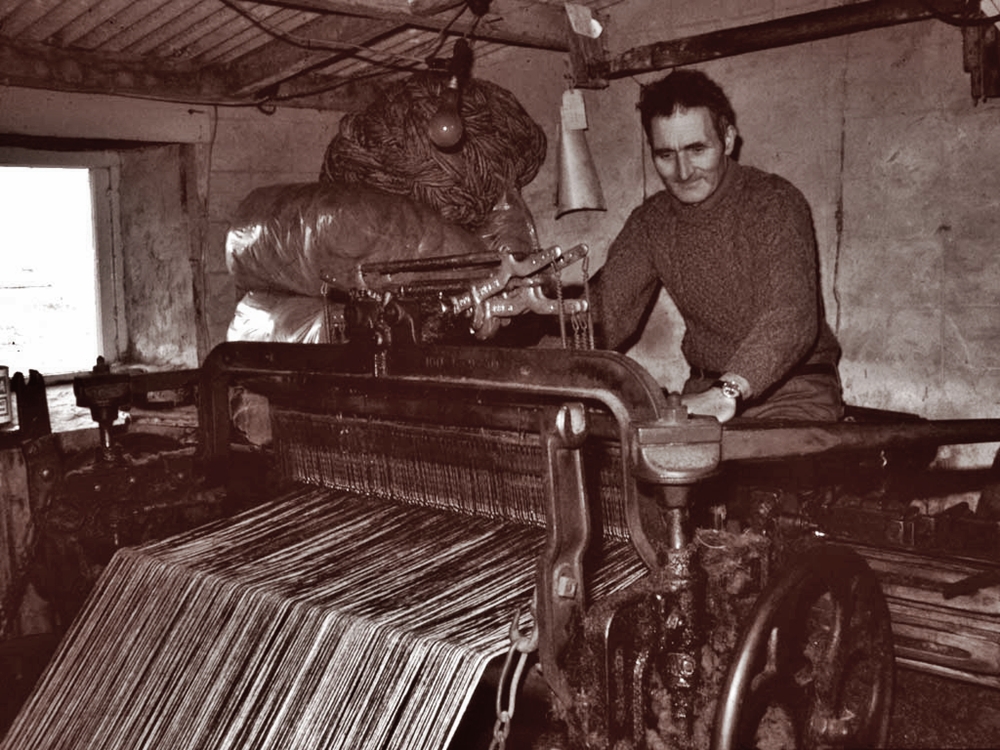Category: Archive photos (page 4)
Valtos School 1904
no images were found
There were 104 pupils at Valtos School in 1904. This key may help with the identification.
1 Mr Cameron
2 Flora Maciver Kneep (Floraidh nighean Mairead Alasdair)
3 Christina Mackay 21 Valtos (Cairstiona Rothaich)
4 Mary Matheson Kneep (Mairi Smiodaidh)
5 Betty Buchanan (Beit Dhomhnaill an t-Saighdear)
6 Barbara Maciver 25 Valtos (Bab Tharmoid Mhurchaidh)
7 Catherine Smith 13 Valtos (Catriona Chaluim a Ghobha)
8 Joan Buchanan 18 Uigen (Seonag Chaluim Mhoir)
9 Dolina Matheson 5 Kneep (Doileag Smiodaidh)
10 Annie Morrison Reithmir (Anna Mhurchaidh Sheumais Reithmir)
The Crowlista Boat
When the Geshader Bull Was Drowned
The Hattersley Loom
Dol’ol at the loom (photo by John Blair). From an article for Uig News by Dave Roberts:
After the First World War there were ex-servicemen who had lost a hand, and one of the reasons for introducing the Hattersley domestic semi-automatic treadle powered loom to the island, was to give them an opportunity to make a living for themselves. Originally designed for the Balkans, Turkey and Greece, these looms eventually caught on for everyone in Lewis and Harris, because of the superior speed of cloth production and the more intricate patterns they could weave. Lord Leverhulme’s interest in the industry, coupled with the serious decline of the herring fishery and the poor price of cured fish from the long line fishery, meant that weaving became a much more important part of the island economy. He had great plans to build weaving sheds close to townships to house a number of Hattersley looms. The weavers would be employed from nine to five, six days a week, weaving tweed for a wage. However this arrangement did not suit crofter-weavers, who would only weave when the croft work allowed, and the idea was eventually dropped.
Hugh Mackay, Carishader, bought the very first Hattersley loom in Uig; it was a single shuttle model. He was a marine engineer, trained in Glasgow, and could strip down the loom and reassemble it without difficulty. If he had a problem, he had no one locally to ask for advice, so he would get on his motorbike and go to Stornoway. However he admitted that quite often he had forgotten the solution, by the time he got back home! In 1936, John Buchanan of No7, Valtos, organised a meeting at Valtos school for local people. Pat Skinner from Kenneth Mackenzie Ltd was there and they arranged for Alasdair Hare from Lochs (mac piuthair Tharmoid Doinn), known as ‘am Breabadair’, to stay in the village for a few weeks. He went from shed to shed teaching as he went.
Lochcroistean School 1934 – the Boys
Tarmod Mòr
Lochcroistean School 1934 – the Girls
Macritchies of 9 Geshader
Valtos
Dolly Doctor
Peter & Chirsty Bell
The Rocket
Mangersta School 1953
Going to the Shieling
From left, Emily Macdonald Gisla, Effie Maclennan 36 Cliff, and two visitors, visiting a shieling.
From Emily’s Twenty Years of Hebridean Memories (1939) – observing from Gisla Lodge the girls going to the shielings at Airigh an Fhorsa and Bo Nighean Mhuirich. The ones Emily mentioned visiting near Loch Coirgeabhat may be at Airigh an Uisge.
Crogabhat, one of our fishing lochs, is a mile from the bungalow, and there we constructed a concrete boathouse which is useful as a lunch hut too when it is cold or wet. About a mile beyond it are two shielings to which we occasionally make an expedition. Shielings are small huts of stone and turf, where girls live for six weeks in the summer while herding the village cattle, brought there to feed on the fresh hill grass of the surrounding moor. This serves a doubt purpose, as it gives the grass round the village a chance to grow, while at the same time the cattle are getting the benefit of moorland feeding. The shielings are often as far as ten miles from the villages, and the day of migration thence is full of excitement.
Of course, we at Gisla can only guess at all the bustle of preparaton that must have gone on since the early morning, but any time after midday the first of the precession begins to pass the bungalow. Groups of cattle of various sizes pass by, accompanied by old women and young girls, and dogs anxiously helping them with the herding. These all turn on to the moor just beyond the boundary of our garden, and there the humans sit down to rest and await their friends still on the road, while the cattle begin to browse, and the dogs fuss around and interest themselves in canine affairs.
After a while, a couple of boats can be seen coming up the loch, and we rush down to the shore to see the unloading. In them are the men, with a miscellaneous collection of bedding, stools, milking pails, churns, meal bags, pots, kettles and all the paraphernalia required for a stay of some weeks on the moor. Also a number of calves too young to walk the whole distance with their mothers and of course more dogs. After leaving the boats, the men load the good into creels which they carry on their backs, and joining the women folk who have already arrived, the whole procession starts off for the distant shielings. There are four lots in Uig [by this stage, when they were falling out of use], and these people I have just described have a much longer way to go than those occupying the sheilings we sometimes visit.



